Estimating the effects of THC on humans (PDF)
File information
Title: estimating the effects of delta – 9 tetrahydrocannabinol
Author: STEVEN ZHOU
This PDF 1.7 document has been generated by Microsoft® Word 2016, and has been sent on pdf-archive.com on 29/01/2018 at 09:40, from IP address 71.84.x.x.
The current document download page has been viewed 305 times.
File size: 736.84 KB (6 pages).
Privacy: public file
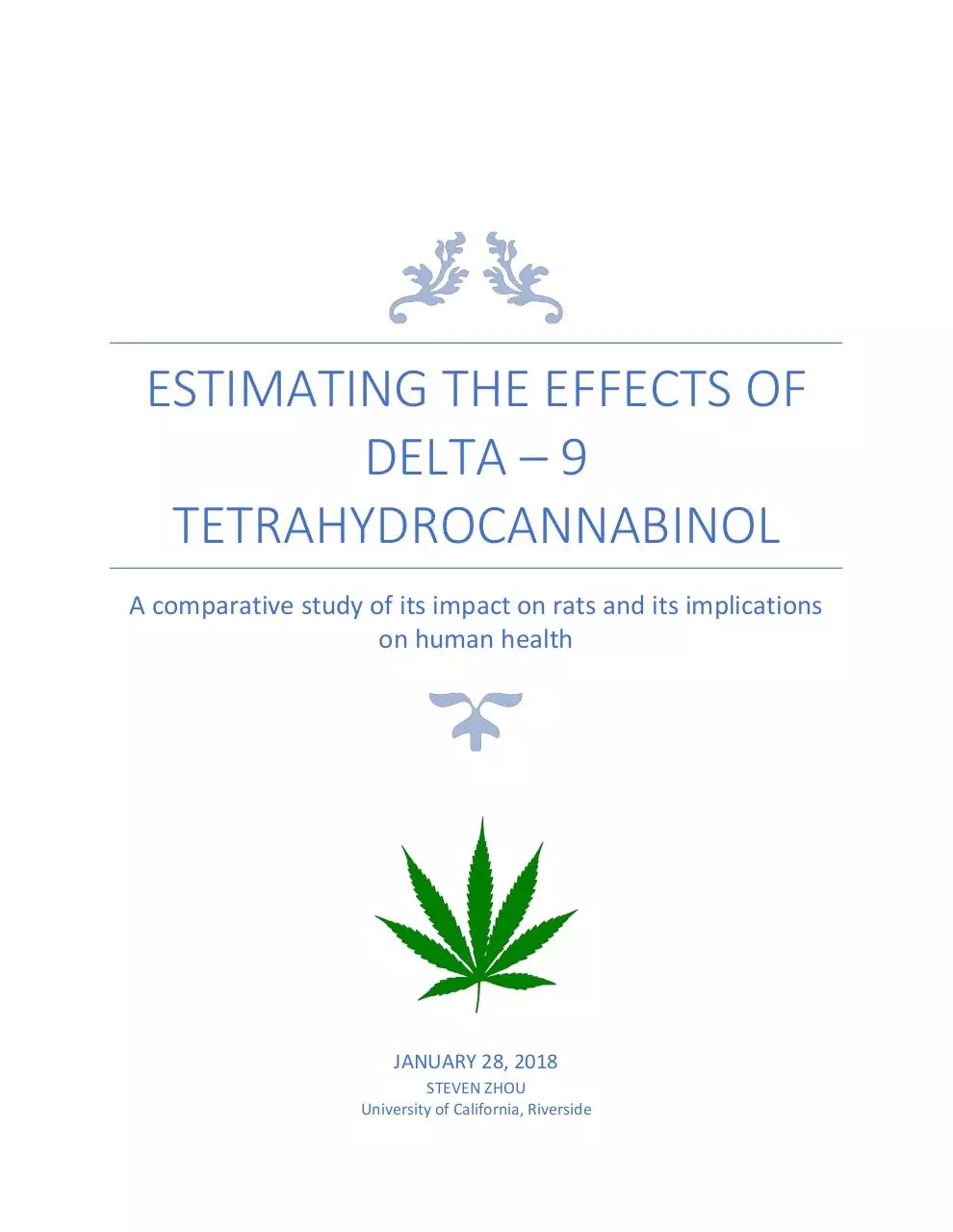
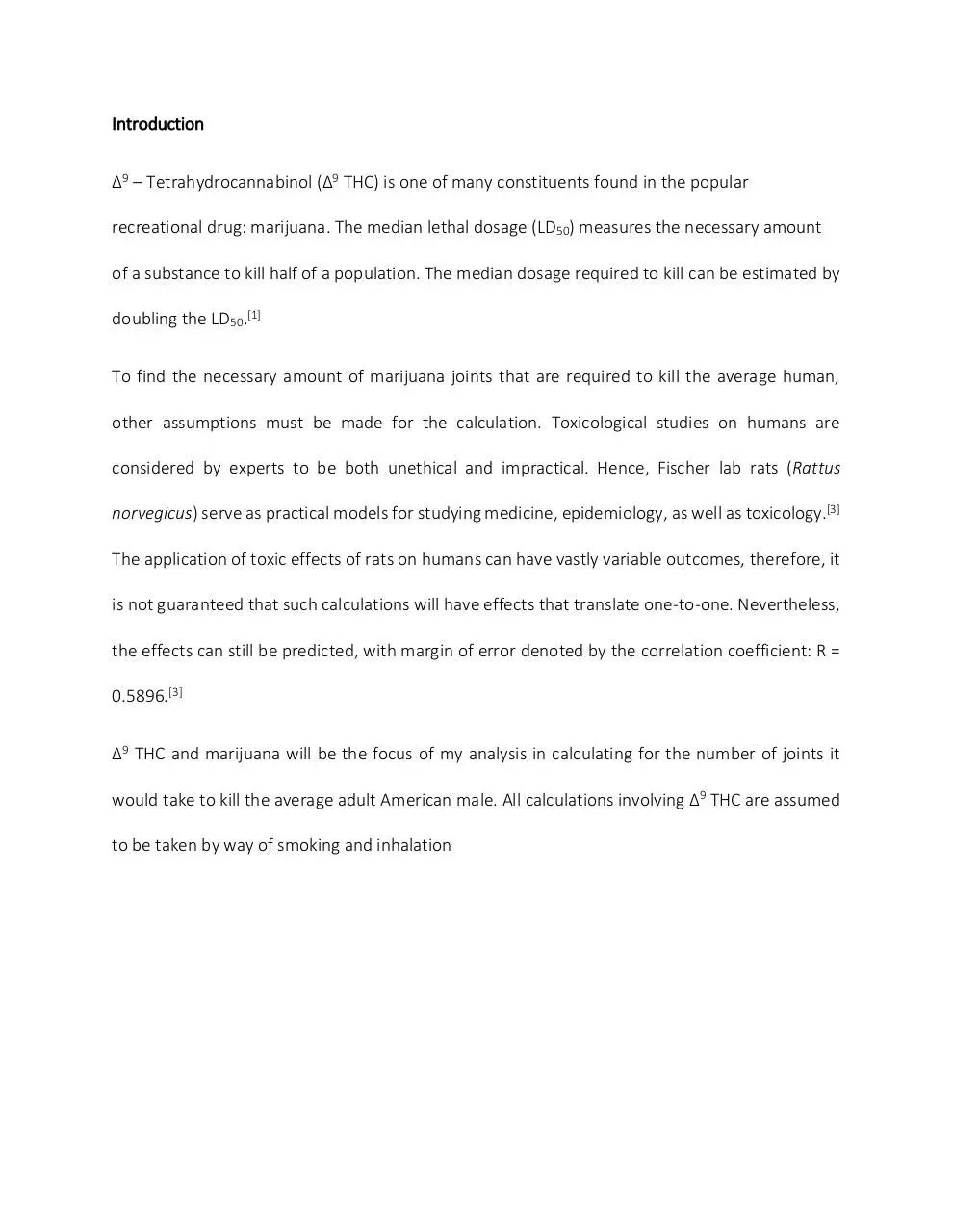
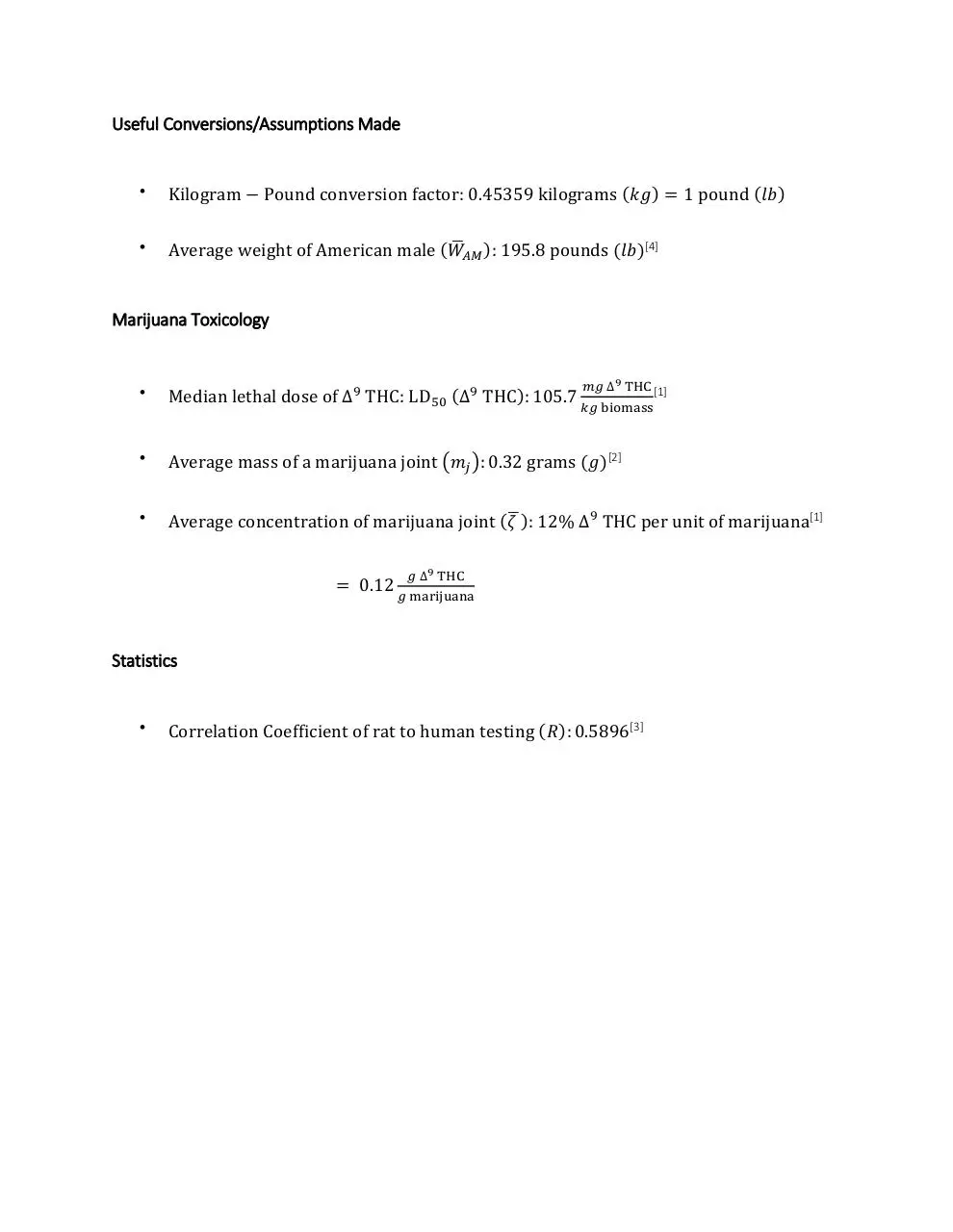
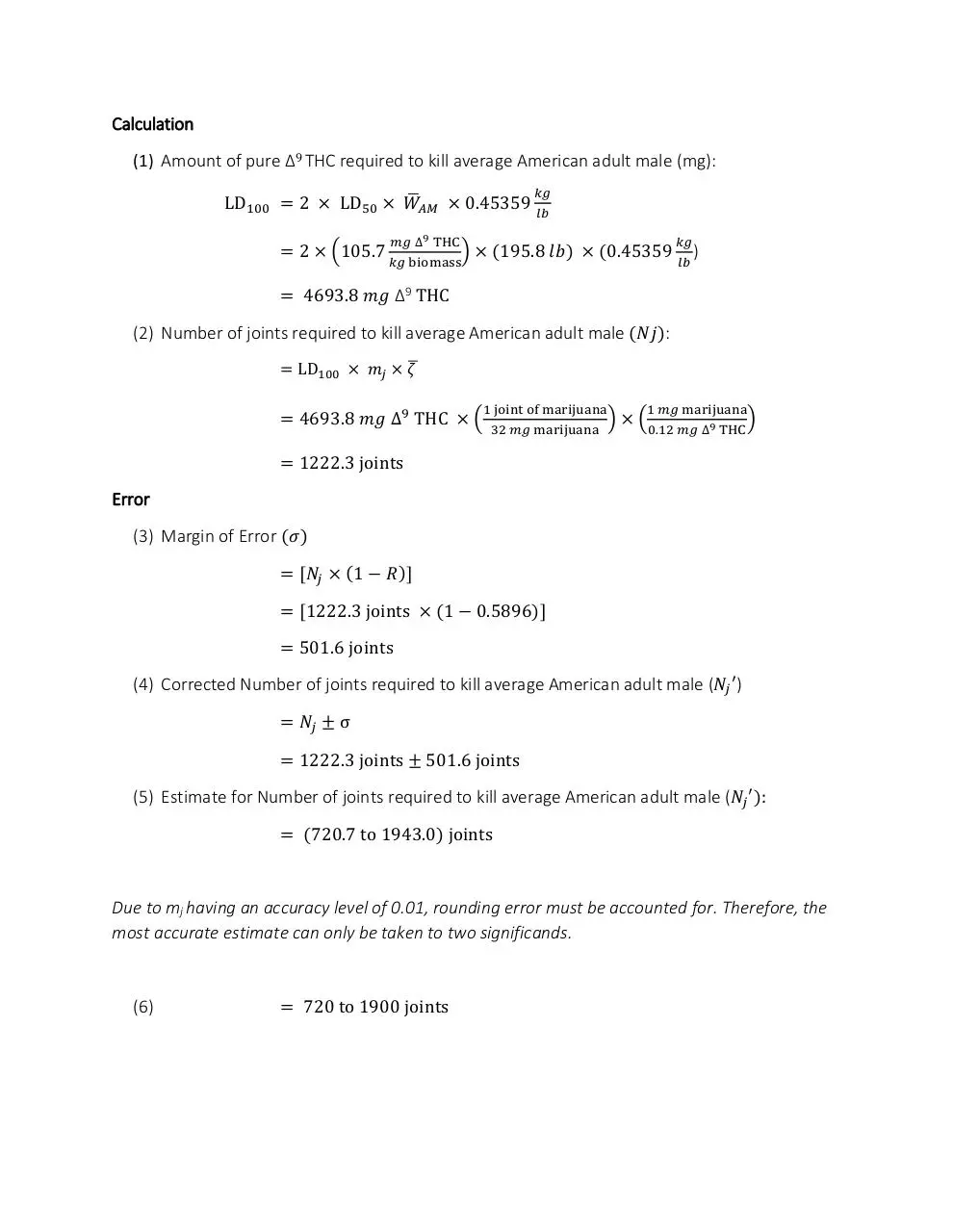
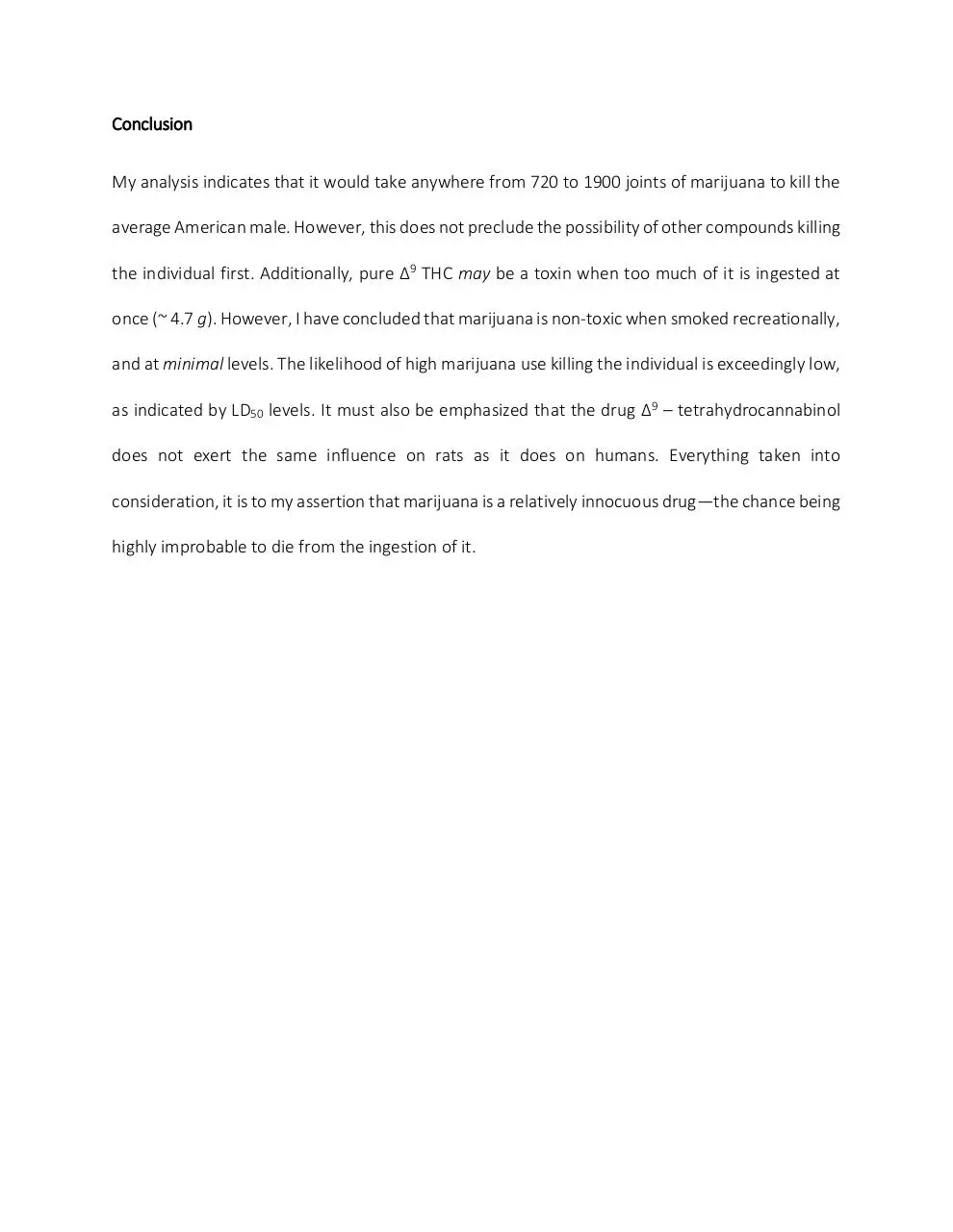
File preview
ESTIMATING THE EFFECTS OF
DELTA – 9
TETRAHYDROCANNABINOL
A comparative study of its impact on rats and its implications
on human health
JANUARY 28, 2018
STEVEN ZHOU
University of California, Riverside
Introduction
Δ9 – Tetrahydrocannabinol (Δ9 THC) is one of many constituents found in the popular
recreational drug: marijuana. The median lethal dosage (LD50) measures the necessary amount
of a substance to kill half of a population. The median dosage required to kill can be estimated by
doubling the LD50.[1]
To find the necessary amount of marijuana joints that are required to kill the average human,
other assumptions must be made for the calculation. Toxicological studies on humans are
considered by experts to be both unethical and impractical. Hence, Fischer lab rats (Rattus
norvegicus) serve as practical models for studying medicine, epidemiology, as well as toxicology.[3]
The application of toxic effects of rats on humans can have vastly variable outcomes, therefore, it
is not guaranteed that such calculations will have effects that translate one-to-one. Nevertheless,
the effects can still be predicted, with margin of error denoted by the correlation coefficient: R =
0.5896.[3]
Δ9 THC and marijuana will be the focus of my analysis in calculating for the number of joints it
would take to kill the average adult American male. All calculations involving Δ9 THC are assumed
to be taken by way of smoking and inhalation
Useful Conversions/Assumptions Made
•
Kilogram − Pound conversion factor: 0.45359 kilograms (𝑘𝑔) = 1 pound (𝑙𝑏)
•
̅𝐴𝑀 ): 195.8 pounds (𝑙𝑏)[4]
Average weight of American male (𝑊
Marijuana Toxicology
𝑚𝑔 ∆9 THC
•
Median lethal dose of ∆9 THC: LD50 (∆9 THC): 105.7 𝑘𝑔 biomass[1]
•
Average mass of a marijuana joint (𝑚𝑗 ): 0.32 grams (𝑔)[2]
•
Average concentration of marijuana joint (𝜁̅ ): 12% ∆9 THC per unit of marijuana[1]
𝑔 ∆9 THC
= 0.12 𝑔 marijuana
Statistics
•
Correlation Coefficient of rat to human testing (𝑅): 0.5896[3]
Calculation
(1) Amount of pure ∆9 THC required to kill average American adult male (mg):
̅𝐴𝑀 × 0.45359 𝑘𝑔
LD100 = 2 × LD50 × 𝑊
𝑙𝑏
𝑚𝑔 ∆9 THC
𝑘𝑔
= 2 × (105.7 𝑘𝑔 biomass) × (195.8 𝑙𝑏) × (0.45359 𝑙𝑏 )
= 4693.8 𝑚𝑔 Δ9 THC
(2) Number of joints required to kill average American adult male (𝑁𝑗):
= LD100 × 𝑚𝑗 × 𝜁̅
= 4693.8 𝑚𝑔 ∆9 THC × (
1 joint of marijuana
32 𝑚𝑔 marijuana
1 𝑚𝑔 marijuana
) × ( 0.12 𝑚𝑔 ∆9 THC )
= 1222.3 joints
Error
(3) Margin of Error (𝜎)
= [𝑁𝑗 × (1 − 𝑅)]
= [1222.3 joints × (1 − 0.5896)]
= 501.6 joints
(4) Corrected Number of joints required to kill average American adult male (𝑁𝑗 ′)
= 𝑁𝑗 ± σ
= 1222.3 joints ± 501.6 joints
(5) Estimate for Number of joints required to kill average American adult male (𝑁𝑗 ′):
= (720.7 to 1943.0) joints
Due to mj having an accuracy level of 0.01, rounding error must be accounted for. Therefore, the
most accurate estimate can only be taken to two significands.
(6)
= 720 to 1900 joints
Conclusion
My analysis indicates that it would take anywhere from 720 to 1900 joints of marijuana to kill the
average American male. However, this does not preclude the possibility of other compounds killing
the individual first. Additionally, pure Δ9 THC may be a toxin when too much of it is ingested at
once (~ 4.7 g). However, I have concluded that marijuana is non-toxic when smoked recreationally,
and at minimal levels. The likelihood of high marijuana use killing the individual is exceedingly low,
as indicated by LD50 levels. It must also be emphasized that the drug Δ9 – tetrahydrocannabinol
does not exert the same influence on rats as it does on humans. Everything taken into
consideration, it is to my assertion that marijuana is a relatively innocuous drug—the chance being
highly improbable to die from the ingestion of it.
References
[1] El Sohly, Mahmoud A., Zlatko Mehmedic, Susan Foster, Chandrani Gon, Suman Chandra,
and James C. Church (2014). “Changes in cannabis potency over the last 2 decades (19952014): Analysis of Current Data in the United States.” Biological Psychiatry, 79 (7). (2016):
613-619.
[2] Ridgeway, Greg, and Beau Kilmer. “Bayesian inference for the distribution of grams of
marijuana in a joint.” Drug and Alcohol Dependence, 165, (2016): 175-180.
[3] Shanks, Niall, Ray Greek, and Jean Greek (2008). “Are animal models predictive for
humans?” Philosophy, Ethics, and Humanities in Medicine, 4 (2). (2009).
[4] Walpole, Sarah Catherine, David Prieto-Merino, Phil Edwards, John Cleland, Gretchen
Stevens, and Ian Roberts (2011). “The weight of nations: an estimation of adult human
biomass.” BMC Public Health, (2012): 12-439.
Download Estimating-the-effects-of-THC-on-humans
Estimating-the-effects-of-THC-on-humans.pdf (PDF, 736.84 KB)
Download PDF
Share this file on social networks
Link to this page
Permanent link
Use the permanent link to the download page to share your document on Facebook, Twitter, LinkedIn, or directly with a contact by e-Mail, Messenger, Whatsapp, Line..
Short link
Use the short link to share your document on Twitter or by text message (SMS)
HTML Code
Copy the following HTML code to share your document on a Website or Blog
QR Code to this page

This file has been shared publicly by a user of PDF Archive.
Document ID: 0000727152.